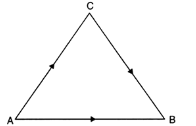With the help of a suitable example, explain the terms distance and displacement.
In Fig. 8.2, suppose a body moves from position A to B through C.
Then, distance travelled = AC + BC

Fig. 8.2
Distance:
i) It is the length of the actual path travelled by a body between its initial and final positions.
ii) Distance is a scalar quantity because it has only magnitude and no direction.
iii) Distance covered is always positive or zero.
iv) Distance describes the total distance moved by an object.
Displacement:
i) The change in the position of an object in a given direction is known as displacement.
ii) It is the shortest distance measured in the direction from the initial to the final position of the body.
iii) Displacement has both magnitude and direction, so it is a vector quantity.
iv) Displacement may be positive, negative or zero.
v) Displacement is used to locate the final position of an object with reference to its initial position at a given time.
vi) The magnitude of displacement is always less than or equal to the distance travelled.



